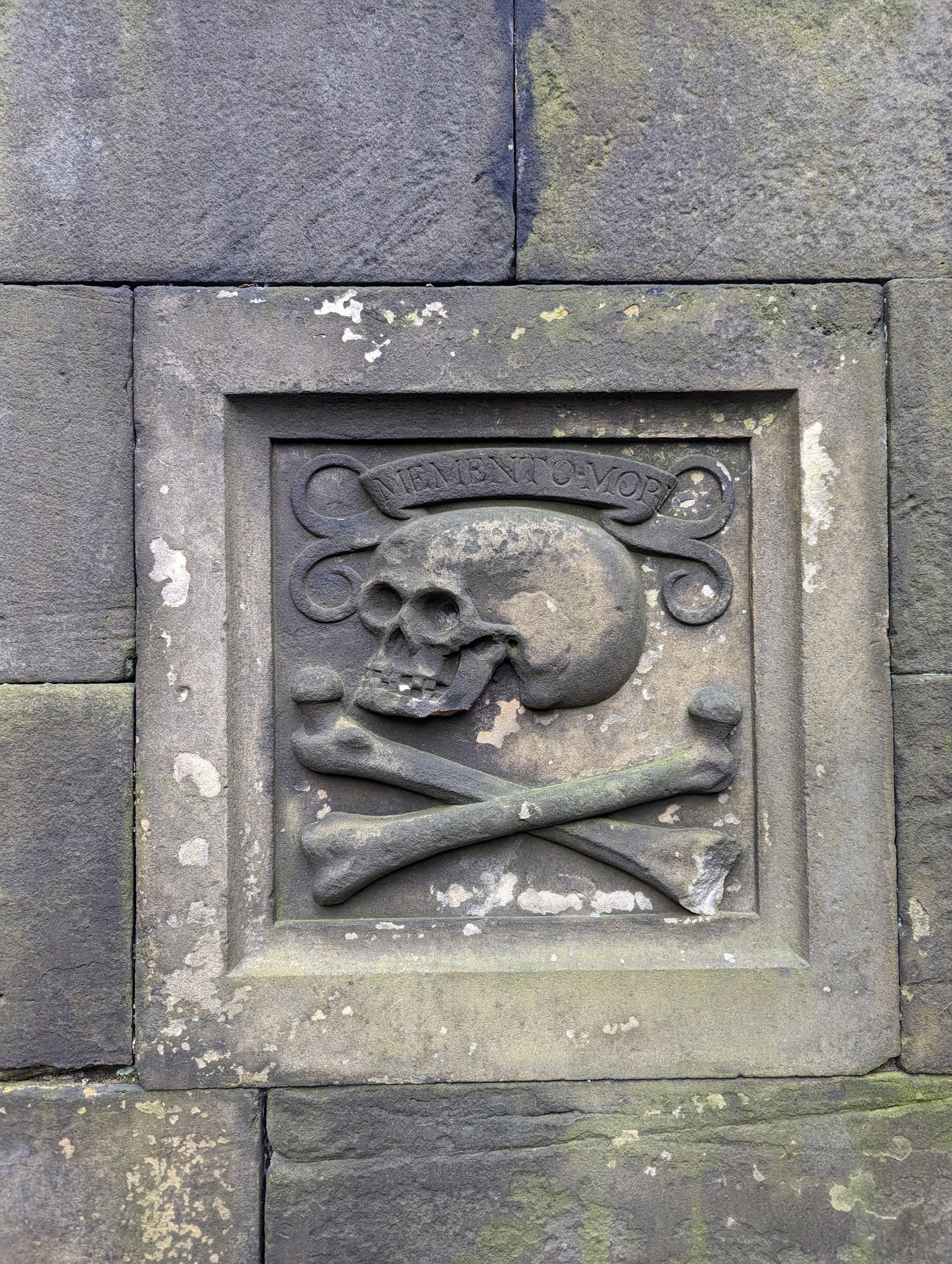Ghost Tours and Bloody Mackenzie
Edinburgh, Scotland: On any given night in Greyfriars Kirkyard, corpses outnumber visitors. The ambiance there is palpable. Decaying tombstones are strewn across muddy grass, the castle looms high and strange, branches creak and moan in the wind. It's no wonder the graveyard is considered one of the world’s most haunted.
But the mysteries of Greyfriars Kirkyard are held deeper. Beneath your feet lie coffins and plague pits, all squished and jostled together like a pungent meat packing plant. Estimates online put the number of bodies anywhere between 100,000 and 500,000.
“It’s the reason the kirkyard is on an upward incline.” I tell my tour group. “Rumour is the ground is only six-inches deep.” I see them shift nervously, their faces lit only by dim light from the church windows nearby. “And when it rains really heavily,” I continue, “someone from the church inspects the grounds to make sure nothing is sticking out of it.”
Some people roll their eyes. Others have their mouths open in shock. I tell them to shut it, quickly, before the spirit of Bloody Mackenzie – the infamous poltergeist who terrorises visitors in Greyfriars Kirkyard – creeps in.
I became a ghost tour guide because it was the first job I was offered when I moved to Edinburgh. I didn’t expect to leave the city with an appreciation of magic that tested the cynical rationalist in me, and a deeper understanding of why we tell such stories in the first place.
I loved the job… about half of the time. It meant braving all weather, forcing 30-odd people through nearly impenetrable crowds during the Edinburgh Fringe Festival and maintaining an exhausting level of extroverted energy. The tours were most strenuous when, every so often, your group would be full of awkward couples who didn’t interact or laugh or smile, and would get annoyed, not delighted, when I made them scream. We tour guides call them energy vampires because they suck the life out of us. It’s why tour guides fight to have American tourists in the group because, generally speaking, they actually get into it (and they tip darn-tootin’ well).
At the end of a shift, my social battery has well expired.
My job also meant wandering Old Town at night dressed as a ghoul, attracting unwanted attention from a group of people that hung out near our tour meet-up point, one of whom yelled “cunt” at me, while another got done for carrying scissors in a pub. Once I saw a man overdose at a bus stop as I headed to my tour group. Minutes later I began making my usual poop jokes to oblivious tourists, holding back tears.
But if appropriately caffeinated and maybe a little drunk, being a ghost tour guide could be loads of fun. It was 75 minutes of behaving as the most extreme version of myself. When others laugh, scream or, yes, even cry, the slap of endorphins and validation was addictive.
Now, as I sit back home in Melbourne, Australia, desk-bound, I miss that bizarre freedom of behaviour.
Fact, rumour, fabrication
My favourite stories were the ones I told in Greyfriars Kirkyard for the graveyard's nerve-jangling ambience. Among the dead, huddled in viscous darkness, fact, rumour and fabrication inextricably entwine.
I tell the story of Irish serial killers Burke and Hare.
Fact: during the 1820s they sold their victims' fresh corpses to a doctor at the University of Edinburgh so he could carry out dissections.
Rumour: William Burke used to be seen with a nightcap and pipe, peering from a window overlooking Greyfriars Kirkyard, watching graves being dug.
Fabrication: “We still see William Burke by the window,” I told my tourists beside a mort safe (a grave surrounded by metal bars to inhibit graverobbers). “He appears as a reflection – you might even mistake it for your own reflection when you walk by.”
But the ghost story of the 17th Century Lord Advocate Sir George “Bloody” Mackenzie was the most interesting to tell. Mackenzie orchestrated the infamous Covenanter's Prison, where he locked up 1,200 Protestants who resisted the Crown’s attempts to impose Anglican practices in the Church of Scotland. Most people died in the prison’s inhumane conditions.
The prison is tucked away behind a gate in the corner of Greyfriars Kirkyard, only a few metres from the dilapidated mausoleum where Mackenzie is buried.
The story goes that in December of 1999, a homeless man wanders into Mackenzie's mausoleum. The floor collapses and he falls into an underground chamber and lands in a mass grave for bubonic plague victims. Their bodies, still a little fleshy from the lack of oxygen, softened his landing.
The next morning, two people opening the church hear quiet, consistent tapping from the mausoleum. When they open its doors, they see the homeless man sitting bolt upright. He is bloodied with scratches, and is shaking so hard that his foot involuntarily tap tap taps against the door.
Over and over, he says:
“That. Face.” This incident awoke Bloody Mackenzie. Since 1999, hundreds of paranormal events have occurred throughout Greyfriars Kirkyard. Some people collapse, some leave the kirkyard covered in scratches, while some see dogs barking at Mackenzie’s mausoleum. Some poor visitors feel like they’ve been kicked or punched by an unseen force.
A professional psychic came on my tour once and urged us to stay back, she could feel a malicious presence. “He does not want us here,” she said. Another visitor felt suddenly cold when he walked in and out of a spot beside a tombstone. A lady felt her sleeves tugged at. No, there was no one behind her.
So is the mausoleum really haunted? Well, Mackenzie's mausoleum was already considered haunted in the time of Treasure Island author, Robert Louis Stevenson. In Stevenson’s writings on Edinburgh published in 1878, he describes children testing their courage at the mausoleum and chanting:
“Bluidy Mackingie, come oot if ye dar'”But did a homeless man really fall through the floor of Mackenzie’s mausoleum? I have absolutely no idea. Did I embellish some details? Of course.
Once, a switched-on tourist asked me how the homeless man got back up to ground level if the floor had collapsed. “Um, there was a ladder,” I poorly improvised. Another asked me if the man caught the bubonic plague after mingling with somewhat intact plague corpses. I lied and said yes, but the hospital gave him some antibiotics.
Once you start questioning the details of ghost stories, the facts start to unravel pretty damn fast.
Another question I was often asked is whether I actually believe in ghosts. I told my tourists yes, but the answer is actually an emphatic no. I am convinced that the many eerie occurrences on my tours could be explained by something mundane. Manifestations of anxiety. Poor plumbing in the underground. But I do believe people were sincere when they had paranormal experiences. Their fear was real, their excitement infectious.
Why we tell ghost stories
The story of Bloody Mackenzie and the homeless man has been told and retold among tourists and locals alike, each with varying details depending on who you ask. Surely, then, this is how stories evolve into folklore.
Whether ghosts, shapeshifting fey, or blood-starved vampires, rumours of monsters are stories we tell to entertain each other, to teach each other, to warn each other, to bring us closer together and to help us understand our place in the world.
From my experiences, I believe we’re drawn to ghost stories for two main reasons.
First, they help us grapple with death. The existence of an afterlife is a seductive answer to humanity’s most burning question: what happens to us, and our loved ones, when we die? On George Mackenzie, Robert Louis Steveson writes:
“When a man’s soul is certainly in hell, his body will scarce lie quiet in a tomb… sometime or other the door must open”.Second: ghost stories sprinkle a little magic into the tedium of reality, even if you, like me, aren't a believer. They give faces and voices to the past, they illuminate darkness with feeling and, crucially, they make us seek intimate company of the living. For example, when I tell Mackenzie’s story I’ve seen couples hold hands, I’ve seen strangers inch closer together, and chivalrous men take the place of unwilling volunteers when I pick on someone to knock on the mausoleum door.
Rediscovering magic
The city of Edinburgh – with its turbulent history of witch burnings and body snatching and its amalgamation of breathtaking architecture – is the perfect setting for such stories. Other than my friends, the thing I miss most about Edinburgh is that it felt like magic was always in your periphery.
Rationally, no, I don’t believe in magic, spirits, ghosts, ghouls, souls, not even God. But at night, when the streets of Edinburgh are quiet and the city is dimly lit, I would feel an inexplicable pull in my chest and my stomach.
The best way I can describe it is that it's like burying your head in a good book and feeling like you're there, physically, within the magic, mystery and adventure of the plot. You stop feeling like you're reading words and instead simply bearing witness to the events of the novel. Moving back home to the suburbs of Melbourne, Australia felt like the book had been rudely snapped shut.
I’m desperately trying to rediscover that sense of magic. But instead of graveyards, alleyways and quiet corners of a historic city, I can find it in the fresh scent of eucalyptus, the abundance of birdlife, and in the deeply ancient kinship with nature of Aboriginal cultures, depicted in their art.
I've learned that there’s something very human about telling each other stories of magic and monsters. My experience telling tales of the restless dead in Edinburgh has opened my eyes to the huge potential of finding fantasy within daily life, wherever that may be.
Photos by Anthea Batsakis






